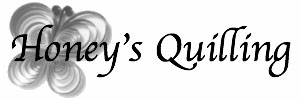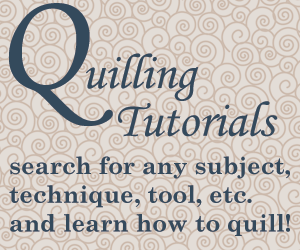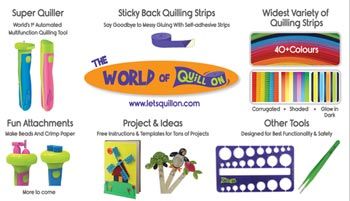Several years ago I posted a tutorial on how to use sealant to make your paper quilled jewelry water resistant. It was actually posted on my first wordpress blog, I transferred it here when I started the new blog. The post covered the three main sealants/topcoats I was using at the time: PPA, liquid matte sealant, and crystal coat glaze. It is a good post, but there are still things to cover and more information to impart, so today I am sharing an add-on to that post.
While I often refer to any product that covers paper quilled jewelry as a sealant, there is actually a difference between a sealant and a topcoat/glaze (though some products do count as both such as PPA). A sealant is usually a product that soaks into a porous surface to prepare it for painting, varnishing, etc. It might be used for wood, pottery, cardboard, etc. If you paint a piece of pottery without using a sealant, the paint would just soak into it and not have as nice of a finish. With using a sealant first you would get a smooth and nice paint finish. So what does that have to do with paper quilled jewelry? Not a lot I guess, but it’s good to know the main purpose of a sealant. When you are using a sealant for paper quilled jewelry, the main purpose of the sealant is to soak into the paper. It makes it stiff and water resistant. If you want the sealant to really soak in well, use a very liquidy sealant such as this one. When you use a thicker sealant like PPA, it actually acts more like a topcoat. Which is fine, but your piece will not be quite as stiff as if you used a liquid sealant. If you put on a couple layers of sealant, you can leave it at that, your jewelry is water resistant.
However, a product that is specifically meant to be only a sealant will not have the level of protection that a topcoat or glaze will give you. I have had some pieces of jewelry that I had only used liquid sealant on and after a couple years of use, they were looking slightly shabby. It’s as if the surface of the sealant kind of wears off. I then spruced it up with some topcoat and they were fine. Jewelry that I used topcoat/glaze on did not get that shabby look.
Using a sealant is actually optional – you can just use a topcoat or glaze on your jewelry and that will be protected as well. However, it won’t be as stiff as if you used a sealant first, and it is easier to fully apply a topcoat if you have already applied a sealant. Click here to read about how to apply a sealant so that your coils don’t come undone.
Today’s post will focus on topcoats and glazes. This assumes that either you have a nice sturdy piece of quilling that won’t uncurl at all (like a plain spiral pendant/earrings or that you have already applied sealant to a piece so it is stiff and the curls won’t come undone.
What You Need:
- A piece of quilled jewelry, already sealed or one that is naturally a very sturdy and simple design.
- Your topcoat or glaze of choice (some good ones are PPA Gloss
, PPA Matte
, Diamond Glaze
, Crystal Coat Glaze
, and 3D Crystal Lacquer
. There are many more options out there, but these are the ones I have used and liked so far. I still have more in my craft cupboard that I need to test (like mod podge and paper glaze) so I can let you know how those work!
Directions:
- Get your supplies set up. Here I am using my plastic covered cork workboard as my working surface. I have my quilled piece which already has been sealed and is completely dry. In the small cap I have some diamond glaze that I added a little water to. You can just use plain diamond glaze, but I wanted a bit of a thinner glaze layer on my piece. For some topcoats or glazes you can add water, but for some you can not. The bottle of diamond glaze says that you can mix it with water, and I have tried several times and it works just fine. However, you can NOT add water to PPA (see here what happens when you do). I’m not sure about other sealants, I haven’t tried it with them.
- Set your piece in your sealant, or hold it above, and liberally paint the glaze all over the piece. Make sure to get the sides and all of the inside spaces.
- Now here is one of my secret tricks! Now that the glaze is all over on the inside spaces, I want to get out all of the extra. There are a couple ways to do this. You could lay the piece on an absorbent facial tissue, that works with some topcoats. Not the thicker ones, though, and your extra topcoat is wasted if you do this. Another way is this trick: Wipe the brush on the edge of the lid or container that your sealant is in, so that the brush is basically empty. Then place the brush on the underside of the quilling piece. The empty brush will work as a sort of a vacuum and suck up the leftover topcoat that is between the spaces. You have to continue dabbing the brush on the piece and then wiping the brush on the edge of your container to get rid of the topcoat that has been absorbed into the brush. Depending on the size of your piece, the number of space, and the thickness of your topcoat, this could be a super quick job or it can take a few minutes. You may need to flip your piece over and repeat on the other side as well.
- Once you have dabbed/absorbed off as much of the excess topcoat as you can, you may be left with some areas still having topcoat in them. You can leave it like this, but when it dries it will still be there, like a super thin window in those places. If you don’t want this, then use your needle tool to pop those areas as shown in the photo below.
- Now it is time for it to dry! It is best if the piece can hang to dry. If it is a pendant usually hang it on a string and let it hang to dry that way. After hanging it up, use the brush to add a little topcoat to the top area where you were hanging onto the piece, as this place might not be as well covered. Once it has been hanging for a few minutes, use the brush to dab on the bottom of the design. This gets rid of any drips of excess topcoat that would have gathered at the bottom. With a thinner topcoat this isn’t such a problem, but if you use a thick one there is more on the piece, so more of a tendency for it to drip to the bottom. If yours was very thick and you didn’t really dab much off, stick around and dab it a few times. It doesn’t look so nice when you have a dried up drip of topcoat at the bottom of your piece of jewelry!
So that’s all there is to it! Basically you coat your piece with the topcoat or glaze, dab off the excess, pop any bubbles/stretched areas of topcoat in spaces, hang it to dry, and dab any drips off the bottom before they dry.
Let me know if you have any questions! Click here to view all of the posts on the blog that are specifically about sealants and/or topcoats, glazes, varnishes, etc.
Stick around and check out some of the other fun stuff on the blog!
Click here to view FREE paper quilling tutorials!
Click here to view paper quilling tips and tricks!
Click here to view a list of places to buy quilling supplies around the world!
Click here to view some of my own quilling projects, with tips so you can make your own if you’d like!
*All products and supplies in this post I purchased on my own.
*This post contains some affiliate links. If you purchase products through the affiliate links I get a small percentage (at no extra cost to you!). I only link to products that I believe in and/or love to use myself. Thank you for supporting my blog!





























Hi Honey~
This is a great post. I didn’t realize the diamond glaze could be diluted so I never bothered with it! I have already bought myself a bottle and look forward to seeing how it will look on some of my pieces. Thanks again for sharing your knowledge!
Hope it works well for you! I like that it can be diluted also, very convenient for when you want a thinner layer
Hi Honey!
This is a fantastic post! Really helped a lot 😀
Where can you buy the diamond glaze?
~Sascha
P.S. Check out my blog: crafty.laingstraits.com
How do you get your blog to become so popular? I am trying to get my blog to become more popular 😀
Cute blog 🙂 looks like you just started this year. Just keep posting and it will slowly grow. Great pictures are very beneficial since you can share them on Pinterest and Facebook.
You can buy Diamond Glaze from Amazon (there is an affiliate link in this post) and you can find it at most craft stores as well like Walmart, Michael’s, etc.